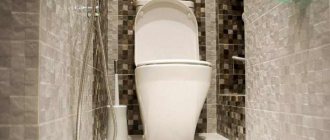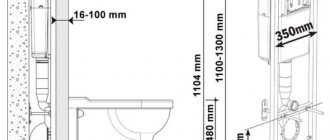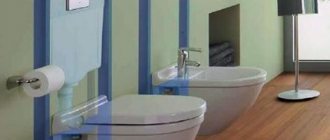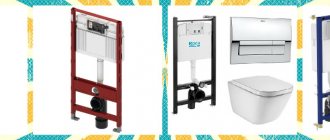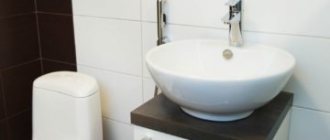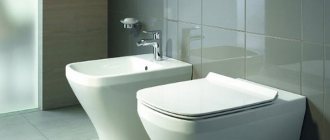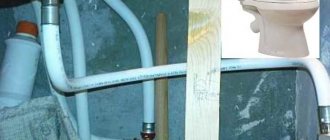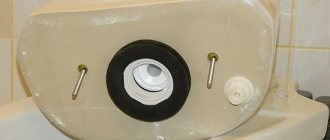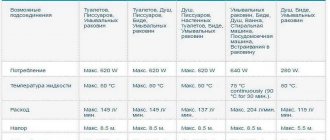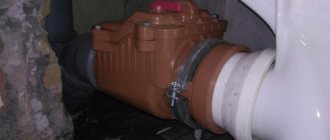In this article:
- Pros and cons of wall hung toilets
- Mounting systems for wall-hung toilets
- Dimensions of wall-hung toilets
- Installation height of wall-hung toilet
- Mounting height of a wall-hung toilet depending on groups of people
- Possible problems when installing a wall-hung toilet
- Common myths about wall-hung toilets
The height of the wall-hung toilet is important when installing it. Without false shame, it worries the vast majority of people. After all, the “place for thinking” must be as convenient as possible.
Choosing a suitable toilet is not as easy as it might seem at first glance. There is a possibility that you will encounter difficulties during its installation, and the model you like simply will not fit into the place intended for it. To prevent this from happening, we suggest that you read our article.
Pros and cons of wall hung toilets
This category of plumbing requires only wall mounting and not floor mounting. The height of the wall-hung toilet is determined depending on your preferences. It turns out that you have the opportunity to choose, while for floor-standing models all sizes are usually the same and determined by the manufacturer. As already mentioned, such plumbing involves fasteners located on the wall, which means you guarantee yourself additional space in the restroom.
Wall-mounted models certainly have their own pros and cons. It is worth emphasizing the clear advantages of wall-hung toilets, thanks to which the demand for this product is steadily growing:
- It becomes easier to clean and disinfect the restroom, since equipment joints, pipe connections and floor fastenings are the most difficult to reach places.
- The design allows for the installation of heated floors in the restroom.
- The installation height of a wall-hung toilet makes it possible to carefully cover pipelines and other unsightly supply elements, making the space look more aesthetically pleasing.
- The small-sized, portable design gives room for imagination in terms of interior solutions, since they will no longer depend on the nuances of the location of plumbing fixtures, as well as on the space occupied by floor-standing toilets.
- Thanks to modern aerator modules, a very thorough cleaning of the internal parts of plumbing equipment is created.
However, wall-mounted models also have their disadvantages, which are associated with the installation height of the wall-hung toilet and the use of this plumbing fixture. It is quite difficult to install such equipment, since you will need to build it into the recess made or mount a special block for it.
Pipe cleaners
More details
During the period of use of plumbing fixtures, if problems arise with the plumbing system, smudges may appear, which are much more difficult to get rid of than in the situation with floor-standing models.
In addition, this is a very expensive undertaking (new components and removal of the structure). However, when installation issues are handled by specialists in their field, the likelihood of encountering such problems in the future is minimized.
Selection process
In order to choose a toilet model that will be comfortable for all members of your family to use, you need to understand several important nuances:
- Price . Depending on the cost, three types of toilets can be distinguished: budget models (usually these include products from domestic manufacturers); models in the middle price segment (as a rule, these are products of Turkish, Czech, Polish manufacturers); luxury models (Swiss, Austrian and German production).
- Height. Everyone in your household should be involved in choosing the height of the toilet. Sit on the model you like: if you are comfortable, your feet touch the floor, and your muscles are relaxed, then this height is suitable for you.
- Flush type. Based on this feature, toilets with direct and circular flush are distinguished. In models of the first type, water moves only in one direction when flushing; this type of flush is considered more economical in terms of water consumption. In models with a circular flush, the toilet bowl is washed with water in two directions, which provides a more thorough cleaning.
- Material. Today, a variety of materials are used to make toilets: plastic, artificial stone, cast iron, steel, porcelain and earthenware. The most modern and the most favorable in terms of price-quality ratio are the last two options.
Mounting systems for wall-hung toilets
Before thinking about what height to hang a wall-hung toilet, you need to study the mounting structure of the equipment - the installation. It is on this that the main element (bowl) and all other parts of the system (tank, pipeline, drain button) are placed. There are 2 types of fasteners: hinged and frame.
- Hinged structureA simple, inexpensive, small-sized system that is installed in a pre-made recess.
Then the necessary components and the bowl itself are placed on the hanging system. The last stage is to cover the recess in the wall with a special waterproof material. Then you can lay tiles, wallpaper, paint, and so on. The main disadvantage of a suspended structure is that it cannot be mounted on weak, narrow blocks made from fragile building materials (plasterboard, plywood, MDF panels). This type of fastening is suitable exclusively for load-bearing walls. The installation height of a wall-hung toilet in this case ranges from 800 to 1000 mm. - Frame structure The frame type is a more complex and more expensive structure, which consists of an iron module (usually coated with a layer that prevents corrosion) that has all the fasteners for the corresponding equipment.
Such plumbing fixtures are quite large in size. The installation height of a wall-hung toilet in this case is from 1000 to 1400 mm, width - from 500 to 600 mm, recesses - from 150 to 300 mm. A clear advantage is the ability to install on almost all building materials.
Before identifying the correct height of a wall-hung toilet, you need to decide on the optimal type of installation:
- In cases where the structure is attached to a gypsum board or foam concrete panel, it is best to choose a model that is mounted to the floor (that is, the frame has two legs that hold the module).
- In the case where the structure is mounted to the main wall, it is best to choose a model that does not have support on the floor, since the load-bearing panel will perfectly withstand such weight.
You can also consider models that combine both fastenings: the frame is mounted both to the wall and to the floor. It is worth considering: the type of installation depends on the required height of the wall-hung toilet and its location in the restroom. For example, when the plumbing is very close to the window, preference should be given to low frames.
Here it is also worth focusing on two types of designs of such plumbing equipment:
- Structures designed for mounting in the corner of a room (slightly inclined, installed on two wall blocks).
- Designs that have a floor traverse, which expands the functionality of the plumbing fixtures by equipping them with a bidet (bathtub with a fountain).
Installation
Installation of a new toilet is carried out after:
- preparing the necessary tools and materials;
- dismantling old plumbing fixtures;
- choosing a model and type of fastening.
To do this, a plan of proposed actions in the bathroom area is drawn up in advance.
Floor mounting options
The toilet is attached to the floor using:
- pedestal (tile) mounted on 2-4 dowels;
- anchors inserted into the floor during screeding and pouring;
- wooden base;
- special corners in the floor;
- glue.
Dimensions of wall-hung toilets
Dimensions are an extremely important aspect that must be taken into account when purchasing plumbing equipment. Based on this indicator, the height of a wall-hung toilet comes in 3 main types:
- Small specimens, not exceeding 540 mm in length. Such options are primarily needed for arranging very small restrooms. This also includes space-saving models installed in the corner. Such plumbing makes it possible to free up space for installing a sink, dryer, and so on.
- The standard height of a wall-hung toilet is 540-600 mm. Thanks to their universal size that fits almost all restrooms, these designs are in high demand.
- Large-sized models - from 600 to 700 mm. Such equipment makes life easier for people with disabilities and the elderly. In addition, such designs are suitable for installation in large rooms.
To determine the height of a wall-hung toilet, you need to take into account individual wishes, as well as the size of the room in which it needs to be placed. For example, a large area will simply visually “dissolve” a small structure, just as a medium-sized one will create inconvenience and take up valuable space in a narrow room.
Height Standards
Over more than a century of history in the production of plumbing equipment, certain standards have been developed regarding the size and installation height of toilets. These figures directly depend on the average height of a person - an indicator that is slowly but surely changing upward. That is why every decade the standard toilet height increases by several millimeters.
The dimensions and height of the toilet installation are shown in the following figure.
Floor
Thus, the standard height of a floor-standing toilet that existed in recent years - 40 cm, is already giving way to a more modern standard - 42 cm. And in some countries, the population of which is made up of especially tall people, toilets of half a meter in height have begun to be produced.
Before choosing, try different options and choose the best one for your height.
Suspension
For wall-hung toilets the numbers will be different. The main thing here is to take into account the distance from the floor level to the bottom edge of the toilet. Ideally it should be 20 cm.
It should be borne in mind that if, after installing the toilet, the installation of the finishing floor covering follows, this distance will be reduced and the position of the toilet will be inconvenient.
Installation height of wall-hung toilet
The height of a wall-hung toilet from the floor is the distance between the flooring in the restroom and the top point of the bowl of plumbing fixtures (the seat and lid are not taken into account). This parameter is affected by the following nuances, which are very important to consider:
- section to the sewer cross (detachable connection of pipelines);
- type and manufacturer of the structure;
- section to the short connecting part of the pipe (pipe);
- personal comfort, the usual dimensions of plumbing fixtures attached to the floor;
- physical properties of the human body.
It's no secret that models attached to the floor are much more familiar to us than variations of modern designs installed on the wall. Every person, upon entering adolescence, already in the subcortex of consciousness gets used to the dimensions of the most common plumbing fixtures, because they are everywhere - apartments, workplaces, places of leisure, and so on.
Let us remind you that the average figure in this case (from the floor covering to the top point of the bowl) is 400-440 mm - a universal option, optimal for most people.
The height of the wall-hung toilet is 450 mm – the “golden mean”. It seems convenient, but it already feels “not right.” But 460 mm and further – it’s difficult to put your feet on the floor; naturally, it’s very uncomfortable and unusual.
Almost all medium-sized plumbing fixtures are equipped with four holes to allow installation of the device. It turns out that during the installation process you can change the width - not the length. But it’s worth considering: the sides of such structures are movable over a distance of about 200 mm. This allows you to change the height of the wall-hung toilet at least a little at will. There are also models equipped with two, three, four holes on both sides, which make it possible to adjust the length by another 50-100 mm. Most standard installation models have 4 holes for studs onto which plumbing fixtures are attached. That is, it is possible to adjust the width, not the height. However, the legs of these installations can be extended by about 20 cm, which ensures vertical adjustment of the studs. There are installations with 2–4 rows of holes for screwing in studs at different heights, which increases the vertical adjustment to 25–30 cm.
Height Standards
Over more than a century of history in the production of plumbing equipment, certain standards have been developed regarding the size and installation height of toilets. These figures directly depend on the average height of a person - an indicator that is slowly but surely changing upward. That is why every decade the standard toilet height increases by several millimeters.
The dimensions and height of the toilet installation are shown in the following figure.
Floor
Thus, the standard height of a floor-standing toilet that existed in recent years - 40 cm, is already giving way to a more modern standard - 42 cm. And in some countries, the population of which is made up of especially tall people, toilets of half a meter in height have begun to be produced.
Before choosing, try different options and choose the best one for your height.
Suspension
For wall-hung toilets the numbers will be different. The main thing here is to take into account the distance from the floor level to the bottom edge of the toilet. Ideally it should be 20 cm.
It should be borne in mind that if, after installing the toilet, the installation of the finishing floor covering follows, this distance will be reduced and the position of the toilet will be inconvenient.
Mounting height of a wall-hung toilet depending on groups of people
You should consider a few tips that are useful in the process of determining the optimal height of a wall-hung toilet, depending on certain features.
- The best option for tall people
If you are tall, the average height of a wall-hung toilet will be too low. The best option here is models ranging in size from 430 mm to 480 mm. This parameter is calculated from the level of the floor covering to the highest point of the bowl. For example, almost all specimens that are attached to the floor do not reach 480 mm. This is why wall-mounted plumbing is the best option for tall people. More variety and more convenient operation.
- Comfortable level for below average height
If your height is below average (up to 1 meter 60 centimeters), the most convenient height standard for a wall-hung toilet will be. As already mentioned, these models have sizes up to 400 mm. It is measured in the same way as in the case of large-sized plumbing fixtures. Toilets with a height of 430 mm or more will be uncomfortable to use, since your feet will not touch the floor. The lack of support in such a situation is even fraught with health problems - diseases of the joints, back, and so on. If you are short and have difficulty using a medium-sized model, you simply need to consider another option for the height of the wall-hung toilet and replace the existing plumbing with a comfortable option.
How to clear a clog with a cable
More details
- Optimal level for people with disabilities
For people with disabilities who use wheelchairs with a special removable block that allows a person to move from a wheelchair to a toilet bowl, the height of the wall-hung toilet must correspond to the size of the vehicle. This way, the person will avoid falling and will not have to make an effort to use the restroom.
Here it is also quite difficult to choose the optimal toilet that is attached to the floor, so preference should be given to modern plumbing. The height of the wall-hung toilet can be adjusted to the required level at any time. But before purchasing such a model, make sure: the fastening mechanism of the device has sufficient “running” to select the optimal parameter, the type of toilet design is suitable for the material of the wall panel, that is, the risk of the frame falling is eliminated. Today you can find specimens that are mounted at a distance of 710 mm from the floor or higher.
- Wall-hung toilet height standards depending on age
Let's consider the optimal parameters for the height of a wall-hung toilet depending on age. The measurement principle is the same as indicated above. Models for children are usually installed in children's hospitals, schools, kindergartens and correspond to the following sizes:
- 3-4 years old – from 270 mm to 300 mm;
- 5-8 years – from 300 mm to 380 mm;
- 9-15 years – from 380 mm to 440 mm.
If we are talking about users who are over 15 years old, the standard height of a wall-hung toilet is from 430 mm to 480 mm.
Selection process
In order to choose a toilet model that will be comfortable for all members of your family to use, you need to understand several important nuances:
- Price . Depending on the cost, three types of toilets can be distinguished: budget models (usually these include products from domestic manufacturers); models in the middle price segment (as a rule, these are products of Turkish, Czech, Polish manufacturers); luxury models (Swiss, Austrian and German production).
- Height. Everyone in your household should be involved in choosing the height of the toilet. Sit on the model you like: if you are comfortable, your feet touch the floor, and your muscles are relaxed, then this height is suitable for you.
- Flush type. Based on this feature, toilets with direct and circular flush are distinguished. In models of the first type, water moves only in one direction when flushing; this type of flush is considered more economical in terms of water consumption. In models with a circular flush, the toilet bowl is washed with water in two directions, which provides a more thorough cleaning.
- Material. Today, a variety of materials are used to make toilets: plastic, artificial stone, cast iron, steel, porcelain and earthenware. The most modern and the most favorable in terms of price-quality ratio are the last two options.
Possible problems when installing a wall-hung toilet
The sewer system in the Russian Federation has natural circulation (all flows in the pipes are directed to the cross). It turns out that if the plumbing is very far from the sewer pipe, then the horizontal pipe slopes too upward. That is why the sewerage system is built in the restroom, or the bowl is mounted next to the pipes, if we are talking about combining a bathroom and a toilet.
The main difficulty in MKD here is the excessive fastening of short tubes, which are outlets in the pipeline. Workers do this either to prevent the pipe from being placed too low, or because they are unable to determine the exact height of the floor covering (for example, when there is no finishing). To establish a comfortable height for a wall-hung toilet, sometimes you have to disassemble the entire structure of the sewer pipes.
In cases where it is not possible to secure the device near the sewer system, for example, when the connector of a short tube is located extremely far away (for example, much further than the 230 mm established by the standards), it is necessary to purchase or make a special podium. It is much more comfortable to step onto a step of the podium, resting your feet on the floor covering, than to feel the terrible inconvenience of its absence without climbing.
If we are talking about a frame frame, its comfortable use may involve the manufacture of a podium. However, it is worth considering: such solutions are not the best idea, as the risk of an accident increases. The best option here is to remake the sewer pipes to the required parameters.
Useful tips
Let us give the reader a number of tips on choosing and installing the plumbing fixtures that interest us.
Like floor-mounted, wall-mounted toilets can be made from various materials.
Let's try to give them a rating.
Polished stainless steel is virtually dirt-free due to its smooth surface. If deposits still remain on it, they can be easily removed using any household chemical product.
- stainless steel.
Why does stainless steel occupy a much smaller market share than competing solutions?
- Somewhat official-looking metal plumbing fixtures. It has become familiar as anti-vandal equipment for public toilets and evokes the appropriate associations among most potential buyers.
- In addition, the cost of stainless steel toilets is much higher than that of clay analogues, and starts from approximately 20,000 rubles.
Glass is not much inferior to stainless steel in practicality; but viewing through the translucent walls what remains on the walls of the bowl below the water level is a rather dubious pleasure.
Sediment and dirt will be very noticeable in a glass toilet.
The main problem with polymer concrete is its limited resistance to harsh cleaning agents and scratches.
Removing urinary stone and lime deposits from it without disturbing the appearance of the surface is a non-trivial task.
The main value of sanitary ware is its low cost. That is why it is the undoubted favorite of the plumbing market. The downside is that its large-porous surface actively collects dirt and often needs cleaning.
Glazed faience, due to its glassy coating, is much more resistant to stains and is considered easier, practically no different in cost from without glaze.
Finally, the best combination of cost and functionality is porcelain.
The walls of the toilet will remain snow-white for a long time; If the need for cleaning does arise, you can safely use acidic and alkaline preparations for it.
Porcelain stays clean longer.
Are there any subtleties to installing a wall-mounted toilet with your own hands?
The installation stages themselves are comprehensively described in the accompanying documentation:
- The location of the installation frame is marked by level or plumb.
- It is anchored to the wall and/or floor.
- Water is supplied to the tank, and a sewer pipe is supplied to the location of the toilet flare.
- The hole in the tank for the drain key is closed with a special membrane or ordinary polyethylene, after which the installation and communications are hidden by a false wall.
As a rule, it is assembled from water-resistant plasterboard along a zinc-coated profile and laid out with tiles. - After the tile has firmly set, the toilet is hung on the installation studs, and a flush button is installed in the tank. A damper gasket is required between the toilet and the wall, distributing the load on the tile and preventing chips from appearing.
The silicone gasket is clearly visible in the photo.
By the way: in the absence of a gasket, silicone sealant can play its role.
There are several aspects here:
- It is better to start laying the tiles from the drain button, so that the seams are located symmetrically relative to the center of the button.
Asymmetry does not look very neat.
- The shorter the sewer line to the riser, the less likely it is to become clogged. Don’t forget about the slope: for pipes with a diameter of 90 and 110 mm used for concealed installation, it is 2 cm per linear meter.
- It is better to collect the sewerage using sealant. The abstract is related to the fact that rubber seals can lose elasticity over time and leak.
- Forget about flexible eyeliners. Water is supplied to the tank by a solid pipe.
The service life of a braided rubber hose rarely exceeds 5 years.
- Despite the fact that the tank’s fittings traditionally allow you to shut off the water through a service hatch behind the drain button, it is better to provide the supply to the tank with a valve and place a hatch in the false wall to access it.
Through the hatch it is easy to get to the valves that shut off the water.
Common myths about wall-hung toilets
This interior solution has gathered many untrue theses, based only on the guesses of those who have not used it personally, but only seen it somewhere on TV. The most famous myth is the inability to cope with a considerable load, and therefore the inability to operate such a device by large users. The height of the wall-hung toilet is achieved by installing an entire iron frame, which has a strong support. Wall-mounted models can easily withstand four hundred kilograms.
In addition, people often think that because the flush module is built into the wall, it is impossible to carry out any repair work or basic equipment checks on it. Here too the thesis is incorrect. The wall-mounted flush release is a removable part that allows access to the entire mechanism.
Another misconception is a possible problem with purchasing additional parts. The statement is unfounded, since, regardless of the large number of manufacturers, each of them is also engaged in the production of component elements.
Despite the imaginary difficulties and, as it seems, large expenses, it is still correct to say: wall-mounted models are very durable, modern and comfortable. You can choose the size, color, material, shape and height of the wall-hung toilet. In addition, such plumbing fixtures are now popular in public places - they facilitate cleaning and fit even in the smallest restrooms.
On the floor or above the floor
In advertising brochures talking about the advantages of wall-hung toilets, the following main points are given:
- Hanging plumbing does not interfere with cleaning , leaving the entire floor area accessible.
- It makes a compact toilet spacious , allowing you to save space due to the tank.
- It allows you to completely hide communications , thereby improving the appearance of the bathroom.
Let's try to find out how much truth there is in marketers' statements.
Free floor
The statement is true without any qualifications. Installation - the frame to which the toilet is attached is hidden behind a false wall, leaving the entire floor area accessible.
This indicates that in your bathroom there will no longer be black and damp places under the tank, that the base of the toilet bowl will not really interfere with cleaning, and to change the tiles you will not need to dismantle it. In addition: the vacated floor will give more scope to your imagination when choosing a flooring pattern.
Compactness
Console plumbing will indeed make the room more spacious, but only visually. The dimensions of a wall-hung toilet with a concealed cistern and installation are at least no smaller than the floor structure: due to the thickness of the false wall, they are likely to be larger.
See: the back wall of the toilet room will move forward by about 20 centimeters, thereby depriving you of the opportunity to use the space behind the toilet for shelves or a small cabinet.
Requirements for the toilet seat
Products on the plumbing accessories market can put an inexperienced buyer in an awkward position. There are many offers, and all claim exceptional quality. But to buy a practical toilet seat, focus on the parameters for assessing the quality of the product.
For unheated rooms, it is better to choose soft seats with a foam rubber inner base and waterproof oilcloth fabric.
Ease of use
Convenience is a parameter that depends on both material support and personal preferences. For one, a soft seat is important, for another, ergonomics and a closer that lowers the seat smoothly.
Appearance
Externally, the seat differs in shape, size, thickness and color. The classic option is a snow-white shade or tones of blue, blue. Original models come with the use of internal colors and fish in a glass frame. Often there are chairs with a wooden frame or made of stone.
Strength of materials
If you don’t want to dig the seat every six months, you need to carefully pay attention to its strength. Unreliable models are made of plastic, sanitary ware and plywood, durable ones are made of stone, wood or duroplast.
High hygiene
Some materials cannot be repaired or should not last longer than 6-9 months. This is justified by sanitary standards and hygiene rules.
For example, plywood does not withstand constant mechanical pressure and water testing, and therefore, if there is a malfunction, it is better to purchase a new seat.
Sanitary ware, duroplast or stone are highly hygienic.
Tools and
Before performing installation work, you must stock up on the necessary tools and equipment. If we talk about x, then there is no universal set, since each model may require various parts, which are traditionally described in the annotation for the toilet.
The list of tools does not depend on the chosen design, therefore for work it is necessary to prepare the following devices:
- drill;
- concrete drills;
- hammer;
- screwdriver with various attachments;
- adjustable wrench;
- FUM tape;
- core;
- corrugation that will cover the sewer pipe;
- level;
- double waterproof plasterboard.
What is a toilet installation?
If the owner wants to install popular wall-hung toilets or bidets, he will also need to install a special structure - an installation. It performs the following functions:
- supports sewer inlet;
- supports the entrance of water pipes;
- sometimes he holds a water tank.
Using wall-hung toilets will free up space and also prevent dampness under the plumbing. Another advantage is that there is no need to dismantle the product if you want to change the floor tiles.
When choosing a location for plumbing fixtures, it is advisable to take into account that the back wall will move forward by 20-25 cm.
The tank is usually made of polymer material. After installation work is completed, it will be impossible to access it, because the built-in system is completely covered with external finishing, for example, ceramic tiles. When installation is completed, the owner will only have access to the ability to regulate using the drain button.
Therefore, it is important to initially purchase high-quality plumbing fixtures, because... If a malfunction occurs, you will need to repeat the procedure: remove the tiles, dismantle the bull, then install the system again. This will cost the apartment owner much more than if you initially buy high-quality plumbing fixtures.
Seat options
For the sake of practicality, do not install a round seat on a square toilet, and vice versa. The remaining parameters depend on the buyer's preferences.
Dimensions
Common sizes of toilet seats are 36.4 cm wide, 46 cm long and 22.5 cm working opening height. Additional sizes:
- 45 cm distance from the mounting axis to the edge of the seat;
- the distance between the two axes of the hole is 14.6 cm.
Other parameters:
- Width – 358 (mm), fasteners 438 (mm) x 146 (mm).
- Width – 360 (mm, fasteners 450 (mm) x 155 (mm).
- Width – 364 (mm), fasteners 453 (mm) x 177 (mm).
- Width – 378 (mm), fasteners 460 (mm) x 220 (mm).
Some manufacturers produce toilets with unusual dimensions and parameters. In this case, you will have to buy a new seat to order from a specific manufacturer.
Form
Toilet lid shapes range from round to square. Not only the external shapes differ, but also the places where the seat comes into contact with the surface. For example, some seat models provide a wider plane at the base and a somewhat narrow outer one.
Non-standard situations
Research has shown that the squatting process, where the hips are lower than the knees, is better for natural bowel movements. If a person suffers from constipation, you can install the wall-mounted model a little lower, so that when using the toilet, your hips drop just below your knees.
For information on what height to install a wall-hung toilet, see the following video.
